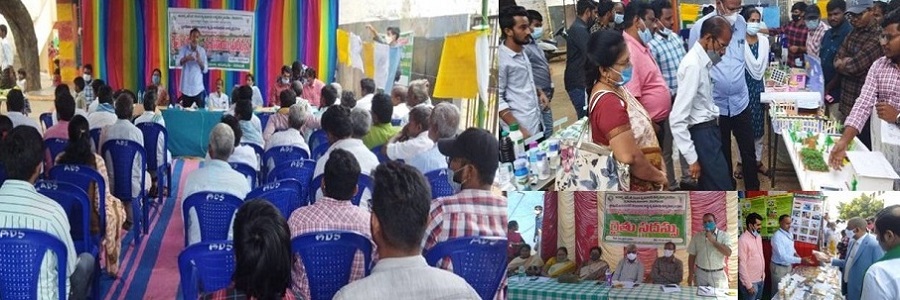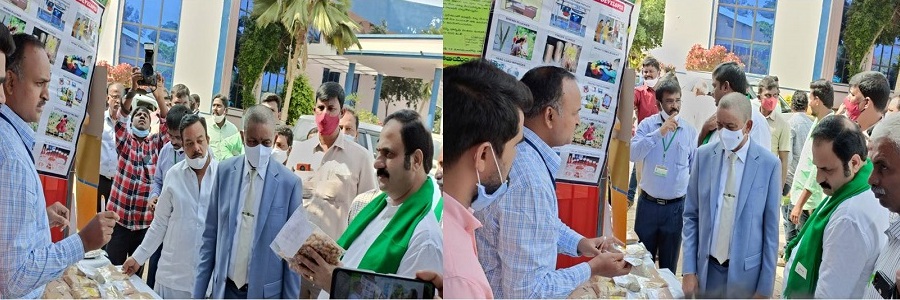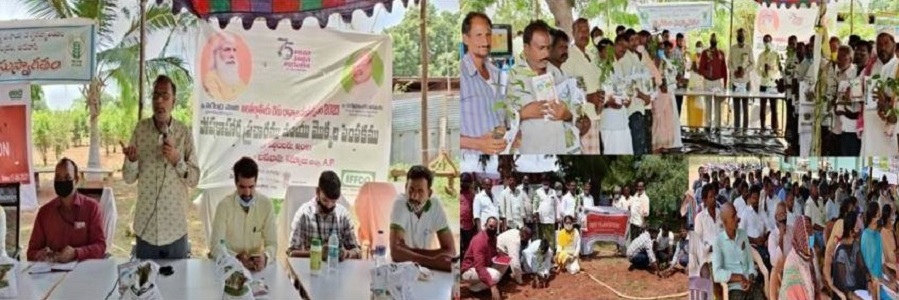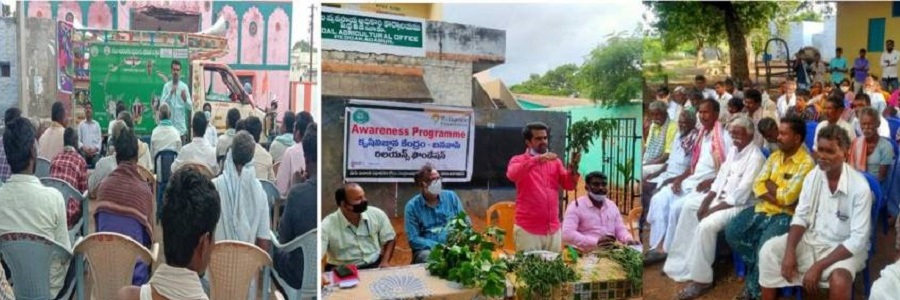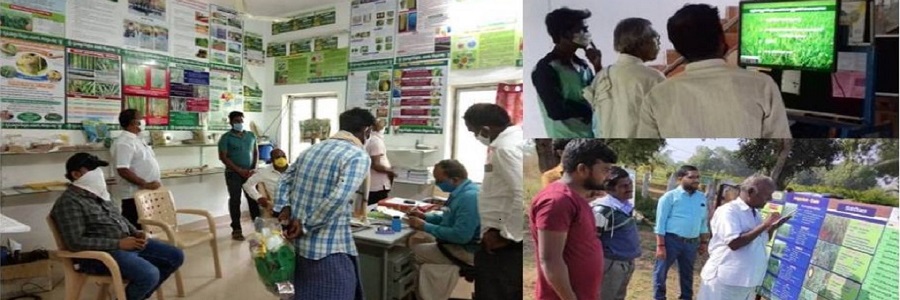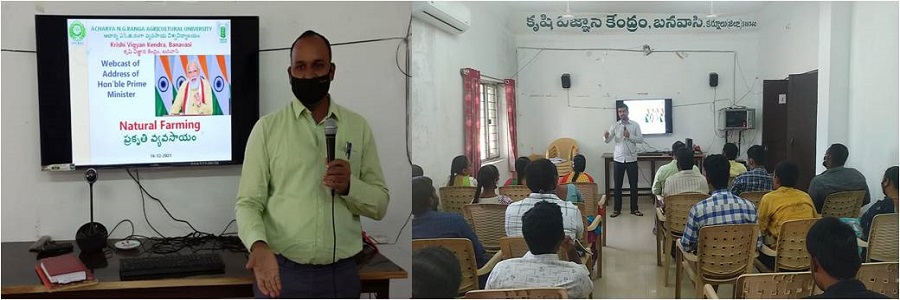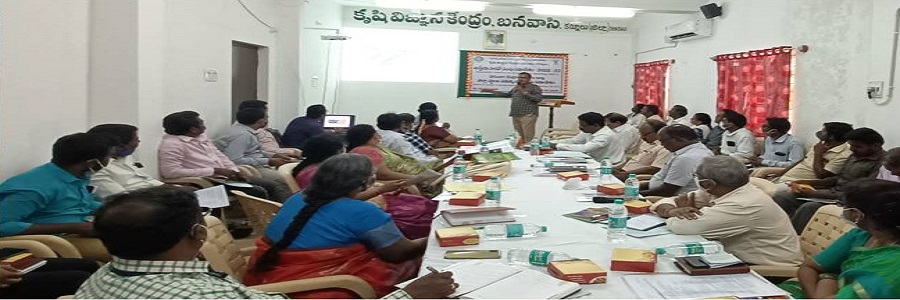Veterinary Science
OFT/01/AH/ KVK/Banavasi/2022-23
1. Name of the technology : Assessment of improved poultry breeds suitable for backyard poultry
2. Nature of intervention : OFT-Kharif- 2022
3. Crop &Farming Situation : Backyard Poultry
4. Objective : To provide farmers with dual purpose poultry breed in backyards, which in turn helps to increase income to farmers
5. Numbered : Approved Achieved
1. No. of farmers : 5 5
6 - 13
|
S. no |
Farmers name |
Village/Mandal |
Name of the Tech. |
Avg. body weight (gm.) |
||||||||||||||||||
|
Ghagus (weeks) |
Vanashree (weeks) |
Desi/ ND |
||||||||||||||||||||
|
4 |
8 |
12 |
16 |
20 |
4 |
8 |
12 |
16 |
20 |
4 |
8 |
12 |
16 |
20 |
||||||||
|
1 |
M. Gopal |
Chennapuram |
T1:Ghagus T2:Vanashree T3: Desi/ ND |
190 |
271 |
378 |
620 |
1024 |
186 |
284 |
395 |
630 |
1186 |
160 |
235 |
310 |
578 |
890 |
||||
|
2 |
M. Dodappa |
Chennapuram |
194 |
284 |
401 |
654 |
1036 |
190 |
292 |
410 |
635 |
1184 |
154 |
234 |
320 |
575 |
885 |
|||||
|
3 |
K. Bajari |
Venkatapuram |
189 |
276 |
410 |
640 |
1048 |
188 |
286 |
405 |
630 |
1190 |
158 |
224 |
315 |
560 |
870 |
|||||
|
4 |
E. Venkataswami |
Kotekal |
187 |
276 |
386 |
625 |
1048 |
190 |
294 |
410 |
645 |
1185 |
162 |
239 |
305 |
570 |
860 |
|||||
|
5 |
K. Raju |
Banavasi |
196 |
279 |
385 |
630 |
1024 |
189 |
286 |
400 |
628 |
1180 |
168 |
240 |
310 |
578 |
900 |
|||||
|
Average |
191 |
277 |
388 |
636 |
1036 |
188 |
287 |
408 |
633 |
1184 |
158 |
234 |
310 |
560 |
885 |
|||||||
|
Treatment |
Mortality (%) |
Age at first lay (days) |
No.of eggs |
Total expenditure (Rs.) |
Gross Returns (Rs.) |
Net Returns (Rs.) |
Benefit Cost Ratio (B: C) |
|||||||||||||||
|
T1 (Ghagus) |
1.1 |
168 |
103 |
390 |
950 |
560 |
1:2.4 |
|||||||||||||||
|
T2 (Vanashree) |
1.8 |
168 |
162 |
450 |
1310 |
890 |
1:3.11 |
|||||||||||||||
|
T3 (Desi/ ND) |
3.1 |
190 |
190 |
150 |
310 |
160 |
1:2 |
|||||||||||||||
14. Farmers reaction :Satisfactory due to more egg production and increased body weight.
15. Constraints : --
16. Feed back
1. To the Scientist : --
2. To the extension personnel:Popularize the rearing of the ghagus and vanashree birds in the backyard.
17. Whether continued during : continued to 2023-24
2022-23 or not reasons
18. Remarks :--
OFT/02/AH/ KVK/Banavasi/2022-23
1. Name of the technology : Assessing the effect of supplementation of Moringa leaf meal in weaned lambs
2. Nature of intervention : OFT-Kharif- 2022
3. Crop &Farming Situation : Sheep extensive rearing system
4. Objective : To decrease the post weaning stress and increase body weight in the post-weaning phase in lambs
5. Numbered : Approved Achieved
1. No. of farmers : 5 5
6 - 13
|
S. no |
Farmers name
|
Village/Mandal
|
Name of the Tech. |
Avg. body weight (Kg.) |
||||||||||||||||||||
|
T1 (days) |
T2 (days) |
FP (days) |
||||||||||||||||||||||
|
0 |
20 |
40 |
80 |
120 |
0 |
20 |
40 |
80 |
120 |
0 |
20 |
40 |
80 |
120 |
||||||||||
|
1 |
K Yeeranna |
Mantralayam |
T1:Concentrate feed with 15% moringa leaf meal, T2: 18% Concentrate feed T3: FP |
7.0 |
10.3 |
15.7 |
20.3 |
24.2 |
7.2 |
9.2 |
12.6 |
18.4 |
21.4 |
7.2 |
8.4 |
11.4 |
13.9 |
16.6 |
||||||
|
2 |
H Shyam kumar |
Chennapuram |
7.1 |
11.1 |
16.3 |
21.4 |
24.7 |
7.3 |
9.3 |
12.4 |
18.1 |
20.9 |
7.3 |
8.1 |
11.2 |
13.6 |
16.34 |
|||||||
|
3 |
E Mahesh |
Venkatapuram |
7.5 |
11.8 |
15.9 |
20.3 |
23.9 |
6.8 |
9.1 |
11.8 |
18.3 |
20.3 |
6.8 |
8.0 |
11.4 |
14.1 |
16.5 |
|||||||
|
4 |
D Mangamma |
Banavasi |
6.9 |
11.4 |
14.8 |
19.6 |
24.4 |
7.0 |
9.3 |
11.7 |
18.4 |
20.2 |
6.9 |
7.9 |
10.8 |
13.6 |
16.7 |
|||||||
|
5 |
M Ramanji |
Kotekal |
7.2 |
10.8 |
15.2 |
20.2 |
25.5 |
7.0 |
9.1 |
11.8 |
18.4 |
20.5 |
7.1 |
8.4 |
11.8 |
13.9 |
16.3 |
|||||||
|
Average |
7.2 |
11.1 |
15.6 |
20.5 |
24.5 |
7.1 |
9.2 |
12.1 |
18.3 |
20.1 |
6.9 |
8.2 |
11.2 |
13.9 |
16.5 |
|||||||||
|
Treatment |
Mortality (%) |
Total expenditure (Rs.) |
Gross Returns (Rs.) |
Net Returns (Rs.) |
Benefit Cost Ratio (B:C) |
|||||||||||||||||||
|
T1 |
11 |
1250 |
9800 |
8550 |
1:7.84 |
|||||||||||||||||||
|
T2 |
18 |
1100 |
8200 |
7100 |
1:7.45 |
|||||||||||||||||||
|
FP |
27 |
1000 |
6600 |
5600 |
1:6.6 |
|||||||||||||||||||
14. Farmers reaction :Satisfactory due to decreased mortality and increased body weight in weaned lambs.
15. Constraints : --
16. Feed back
1. To the Scientist : --
2. To the extension personnel: To create awareness in the sheperds regarding of moringa concentrate feeding to the weaned lambs.
17. Whether continued during
2022-23 or not reasons: continued to 2023-24
18. Remarks: --
OFT/03/AH/ KVK/Banavasi/2022-23
1. Name of the technology : Assessing the effect of bypass fat supplementation to fattening ram lambs
2. Nature of intervention : OFT-Rabi - 2022
3. Crop &Farming Situation : Sheep extensive rearing system
4. Objective : To increase the daily body weight gain in lambs
5. Numbered : Approved Achieved
1. No. of farmers : 5 5
6 - 13
|
S. no |
Farmers name
|
Village/Mandal
|
Name of the Tech. |
Avg. body weight (Kg.) |
|||||||||||||||
|
T1 (days) |
T2 (days) |
FP (days) |
|||||||||||||||||
|
0 |
30 |
60 |
120 |
0 |
30 |
60 |
120 |
0 |
30 |
60 |
120 |
||||||||
|
1 |
Venkatesh naidu |
Mantralayam |
T1:Concentrate feed along with bypass fat T2: Concentrate feed T3: Farmer practice |
10.8 |
14.6 |
19.3 |
24.8 |
10.3 |
13.4 |
17.5 |
20.4 |
10.2 |
12.1 |
15.2 |
18.8 |
||||
|
2 |
Anil kumar |
Banavasi |
11.2 |
15.2 |
20.1 |
25.3 |
9.8 |
12.8 |
17.0 |
20.6 |
9.9 |
11.9 |
15.4 |
18.1 |
|||||
|
3 |
Bala veerayya |
Banavasi |
11.4 |
15.1 |
20.3 |
25.8 |
10.6 |
12.9 |
17.5 |
21.0 |
10.4 |
12.1 |
15.6 |
18.9 |
|||||
|
4 |
Thayappa |
Muguthi |
10.6 |
14.6 |
19.5 |
24.3 |
9.9 |
12.7 |
17.3 |
20.1 |
10.1 |
11.7 |
15.1 |
18.1 |
|||||
|
5 |
Farooq |
Kotekal |
11.2 |
15.2 |
19.9 |
25.8 |
10.2 |
13.0 |
17.2 |
20.1 |
10.4 |
11.8 |
14.3 |
18.1 |
|||||
|
Average |
11.1 |
15.0 |
19.5 |
25.5 |
10.2 |
13.0 |
17.4 |
20.2 |
10.0 |
11.8 |
14.9 |
18.1 |
|||||||
|
Treatment |
Mortality (%) |
Total expenditure (Rs.) |
Gross Returns (Rs.) |
Net Returns (Rs.) |
Benefit Cost Ratio (B:C) |
||||||||||||||
|
T1 |
10 % |
1250 |
10200 |
8950 |
1:8.1 |
||||||||||||||
|
T2 |
22 % |
1100 |
8080 |
8080 |
1:7.3 |
||||||||||||||
|
FP |
32 % |
1000 |
6400 |
5400 |
1:6.4 |
||||||||||||||
14. Farmers reaction :Satisfactory due to decreased mortality and increased body weight.
15. Constraints : --
16. Feed back
1. To the Scientist: --
2. To the extension personnel: Create awareness in the farmers regarding of bypass fat feeding to the weaned lambs.
17. Whether continued during
2022-23 or not reasons : continued to 2023-24
18. Remarks : --
OFT/04/AH/ KVK/Banavasi/2022-23
1. Name of the technology : Assessing the effect of probiotic yeast supplementation on milk yield in milch animals
2. Nature of intervention : OFT-Rabi - 2022
3. Crop &Farming Situation : Dairy farming
4. Objective : Improving the animal health condition thereby increasing milk yields using probiotics
5. Numbered : Approved Achieved
1. No. of farmers : 5 5
6 - 13
|
S. no |
Farmers name
|
Village/Mandal
|
Name of the Technology |
Avg. body weight (Kg.) |
|||||||||
|
T1 (days) |
T2 (days) |
FP (days) |
|||||||||||
|
Milk (L) |
Fat (%) |
Milk (L) |
Fat (%) |
Milk (L) |
Fat (%) |
||||||||
|
1 |
Giddayya |
Kotekal |
T1:Probiotic yeast (15gms/day) + 2 % sodium bi carbonate T2: Probiotic yeast (15gms/day) T3:Farmer practice |
720 |
4.4 |
690 |
4.0 |
648 |
3.1 |
||||
|
2 |
J Vasanth kumar |
Banavasi |
711 |
4.3 |
685 |
3.9 |
650 |
3.0 |
|||||
|
3 |
V Ramudu |
Venkatapuram |
690 |
4.1 |
670 |
3.8 |
635 |
3.15 |
|||||
|
4 |
P Jaleel basha |
Kosgi |
722 |
4.2 |
692 |
4.0 |
620 |
3.20 |
|||||
|
5 |
B Rangappa |
Chennapuram |
695 |
3.9 |
690 |
3.78 |
618 |
3.15 |
|||||
|
Average |
707.5 |
4.18 |
685 |
3.9 |
634.5 |
3.1 |
|||||||
|
Treatment |
Total expenditure (Rs.) |
Gross Returns (Rs.) |
Net Returns (Rs.) |
Benefit Cost Ratio (B:C) |
|||||||||
|
T1 |
700 |
2920 |
2220 |
1:4.17 |
|||||||||
|
T2 |
520 |
2020 |
1500 |
1:3.8 |
|||||||||
|
FP |
- |
- |
- |
- |
|||||||||
14. Farmers reaction :Increased milk yield and fat% in animals supplemented with probiotics.
15. Constraints : --
16. Feed back
1. To the Scientist : --
2. To the extension personnel: To popularise usage of probiotics to milch animals
17. Whether continued during
2022-23 or not reasons:continued to 2023-24
18. Remarks:: --
FLD/01/AH/ KVK/Banavasi/2022-23
1. Name of the technology :Demonstration of double PgF2α protocol to improve the breeding efficiency in milch buffaloes
2. Nature of intervention : FLD-Kharif - 2022
3. Crop &Farming Situation : Dairy farming
4. Objective : To increase the reproductive, productive performance and to decrease the calving interval
5. Numbered : Approved Achieved
1. Area : -- --
2. No. of farmers : 10 10
6. –13
|
S. no |
Farmers name |
Village/Mandal |
Name of the Tech. |
Heat detected (%) |
Conception (%) |
||
|
T1 |
Farmer Practice |
T1 |
Farmer Practice |
||||
|
1 |
G Krishna |
Chinnatumbalam |
T1: Double PgF2α Protocol T2: Farmer Practice |
95.1 |
64 |
98 |
58 |
|
2 |
K Sriramulu |
Chinnatumbalam |
89.5 |
66 |
92 |
55 |
|
|
3 |
K. Narsanna |
Banavasi |
92.3 |
64 |
93 |
56 |
|
|
4 |
V. Raghuveera |
Yemmiganur |
93.5 |
60 |
90 |
50 |
|
|
5 |
Yellappa |
Banavasi |
94.5 |
61 |
90 |
52 |
|
|
6 |
E. Srinivasulu |
Hamnumapuram |
91.6 |
60 |
92 |
50 |
|
|
7 |
K. Satyanarayana |
Errakota |
93.4 |
60 |
93 |
52 |
|
|
8 |
K. Lakshmikanth |
Errakota |
94.4 |
61 |
89 |
50 |
|
|
9 |
Ashok |
Merugudhoddi |
95 |
68 |
87 |
52 |
|
|
10 |
Ramanjaneyulu |
Banavasi |
89 |
58 |
85 |
52 |
|
|
Average of Treatments |
93.4 |
61.6 |
92.2 |
52.9 |
|||
|
Treatments |
Cost of expenditure |
Gross returns (Rs) |
Net returns (Rs) |
Cost benefit ratio (C:B) |
|
T1 |
240 |
1600 |
1360 |
1:6.6 |
|
Farmers practice |
160 |
-- |
-- |
-- |
14. Farmers reaction :Farmers were satisfied with the technology and it effectively increased the oestrous rate in dairy animals.
15. Constraints :--
16. Feed back
1. To the Scientist : --
2. To the extension personnel:Create awareness on usage of PgF2α protocol in milch animals
17. Whether continued during :Continued to 2023-24
2022-23 or not reasons
18. Remarks :--
FLD/02/AH/ KVK/Banavasi/2022-23
1. Name of the technology :Demonstration of Influence of diet along with supplementation on the Incidence of mastitis (Clinical and/subclinical) incows or buffaloes.
2. Nature of intervention : FLD-Rabi - 2022
3. Crop &Farming Situation : Dairy farming
4. Objective : To diagnose and manage sub clinical mastitis in dairy cattle and minimize the economic loss to the farmer from occurrence of Sub
clinical mastitis
5. Numbered : Approved Achieved
1. Area : -- --
2. No. of farmers : 10 10
6. –13
|
S. no |
Farmers name |
Village/Mandal |
Name of the Tech. |
Mastitis incidence (%) |
Milk yield (L) |
||
|
T1 |
Farmer Practice |
T1 |
Farmer Practice |
||||
|
1 |
G Govindhu |
Banavasi |
T1:Mineral mixture (40 gms/day 4 weeks before calving), Vit-A and Vit-E+ selenium tonic (4 weeks before calving) T2: FP |
3.0 |
92 |
13 |
45 |
|
2 |
KKrishnayya |
Hamnumapuram |
2.0 |
88 |
15 |
48 |
|
|
3 |
K. V. Naidu |
Errakota |
2.5 |
85 |
17 |
47 |
|
|
4 |
V. Raghavendra |
Errakota |
1.5 |
90 |
12.5 |
44 |
|
|
5 |
P. Yeeranna |
Merugudhoddi |
1.5 |
84 |
16 |
43 |
|
|
6 |
E. Srinivasulu |
Banavasi |
2 |
90 |
18 |
42 |
|
|
7 |
M. Kiran kumar |
Chinnatumbalam |
2 |
88 |
16 |
41 |
|
|
8 |
S. Lakshmanna |
Banavasi |
2.5 |
90 |
19 |
40.5 |
|
|
9 |
P.Yesu |
Yemmiganur |
1.5 |
88 |
15 |
47 |
|
|
10 |
Ramanjaneyulu |
Banavasi |
2.0 |
92 |
16.5 |
41 |
|
|
Average of Treatments |
2.0 |
88.0 |
15.5 |
44.3 |
|||
|
Treatments |
Cost of expenditure |
Gross returns (Rs) |
Net returns (Rs) |
Cost benefit ratio (C:B) |
|
T1 |
1200 |
3520 |
2320 |
1:2.9 |
|
Farmers practice |
- |
1760 |
- |
- |
14. Farmers reaction :Farmers were satisfied with the technology and effectively decreased the mastitis percent in milch animals.
15. Constraints :--
16. Feed back
1. To the Scientist: --
2. To the extension personnel:Create awareness on usage of vit-A,vit-E and selenium injection before one month of parturition.
17. Whether continued during: Continued to 2023-24
2022-23 or not reasons
18. Remarks :--
FLD/03/AH/ KVK/Banavasi/2022-23
1. Name of the technology :Demonstration of mixed fodder production (cereal + Legume)
2. Nature of intervention : FLD-Kharif - 2022
3. Crop &Farming Situation : Fodder
4. Objective : Intercropping of legume fodders with non-legume fodders improves the nutritional value of the fodder produced.
5. Numbered : Approved Achieved
1. Area : -- --
2. No. of farmers : 10 10
6. –14
|
S. no |
Farmers name |
Village/Mandal |
Name of the Tech. |
Yield (t/ha) |
Milk yield (L) for 30 days |
||
|
T1 (6-7 cuts/year) |
Farmer Practice (single cut/year) |
T1 |
Farmer Practice |
||||
|
1 |
M. Sundaramma |
Masumandoddi |
T1: COFS 29 + Hedge lucerne T2: FP |
210.5 |
45.5 |
90.5 |
63.5 |
|
2 |
K.VenkataSubbamma |
Errakota |
212.5 |
50.6 |
91.6 |
62.4 |
|
|
3 |
K.Chinnodu |
Errakota |
220.1 |
51.6 |
98.5 |
61.4 |
|
|
4 |
B.Uthayya |
Masumandoddi |
225.2 |
49.6 |
93.4 |
63.1 |
|
|
5 |
M.Subbarayudu |
Banavasi |
221.5 |
48.5 |
91.5 |
60.4 |
|
|
6 |
D.Obuleshu |
Kotekal |
220.5 |
49.5 |
92.5 |
62.1 |
|
|
7 |
D.Balaraju |
Venkatagiri |
215.4 |
54.8 |
90.1 |
63.1 |
|
|
8 |
M.Obuleshu |
Banavasi |
215.8 |
52.7 |
92.1 |
61.2 |
|
|
9 |
S.Sekhar |
Yemmiganur |
228.4 |
52.4 |
90.1 |
66.5 |
|
|
10 |
Nagamani |
Banavasi |
228.5 |
52.1 |
92.1 |
61.5 |
|
|
Average of Treatments |
219.2 |
50.73 |
92.24 |
62.52 |
|||
|
Treatments |
Cost of expenditure |
Gross returns (Rs) |
Net returns (Rs) |
Cost benefit ratio (C: B) |
|
T1 |
1600 |
3700 |
2100 |
1:2.32 |
|
Farmers practice |
1200 |
2500 |
1300 |
1:1.9 |
14. Farmers reaction :Farmers were satisfied with the technology and effectively increased fodder yield and milk yield in milch animals.
15. Constraints :--
16. Feed back
1. To the Scientist: --
2. To the extension personnel:To promote mixed fodder cultivation.
17. Whether continued during: Continued to 2023-24
2022-23 or not reasons
18. Remarks :Palatability is good, fodder yields are optimum under normal irrigation conditions.
FLD/04/AH/ KVK/Banavasi/2022-23
1. Name of the technology :Demonstration of milk replacer for pre-waned lambs
2. Nature of intervention : FLD-Rabi - 2022
3. Crop &Farming Situation : Sheep extensive rearing system
4. Objective : Milk replacer provides adequate nutrients for growing lambs
5. Numbered : Approved Achieved
1. Area : -- --
2. No. of farmers : 10 10
6. –13
|
S. no |
Farmers name |
Village/Mandal |
Name of the Tech. |
Mortality (%) |
Weight gain (Kg) |
||
|
T1 |
Farmer Practice |
T1 |
Farmer Practice |
||||
|
1 |
T. Sivamma |
Kotekal |
T1: Milk replacer T2: FP |
8.5 |
21.5 |
17.5 |
11.2 |
|
2 |
A. Sumalatha |
Venkatagiri |
6.1 |
20.2 |
18.1 |
10.2 |
|
|
3 |
G. Ramalakshamma |
Banavasi |
7.2 |
21.6 |
19.5 |
10.5 |
|
|
4 |
C. Parvathi |
Yemmiganur |
6.8 |
21.3 |
18.5 |
11.3 |
|
|
5 |
C. Narayana |
Banavasi |
7.1 |
21.5 |
18.5 |
10.4 |
|
|
6 |
V. Mallikarjuna |
Masumandoddi |
8.1 |
24.6 |
18.2 |
12.6 |
|
|
7 |
G. Rama Devi |
Errakota |
7.5 |
23.4 |
17.9 |
10.8 |
|
|
8 |
G. Mohan |
Errakota |
7.5 |
22.4 |
17.6 |
9.5 |
|
|
9 |
K. Bala Guravaih |
Masumandoddi |
6.5 |
21.3 |
17.5 |
9.8 |
|
|
10 |
G. Prathap |
Banavasi |
6.1 |
20.1 |
18.6 |
10.2 |
|
|
Average of Treatments |
7.14 |
21.88 |
18.19 |
10.6 |
|||
|
Treatments |
Cost of expenditure |
Gross returns (Rs) |
Net returns (Rs) |
Cost benefit ratio (C:B) |
|
T1 |
1250 |
5430 |
4680 |
1:4.3 |
|
Farmers practice |
- |
3210 |
- |
- |
14. Farmers reaction:The farmers said that they the pre weaned feed with milk replacer gained weight and showed low mortality and were satisfied with the technology.
15. Constraints :--
16. Feed back
1. To the Scientist: --
2. To the extension personnel: To popularize the usage of milk replacer in lambs.
17. Whether continued during: Continued to 2023-24
2022-23 or not reasons
18. Remarks : --




